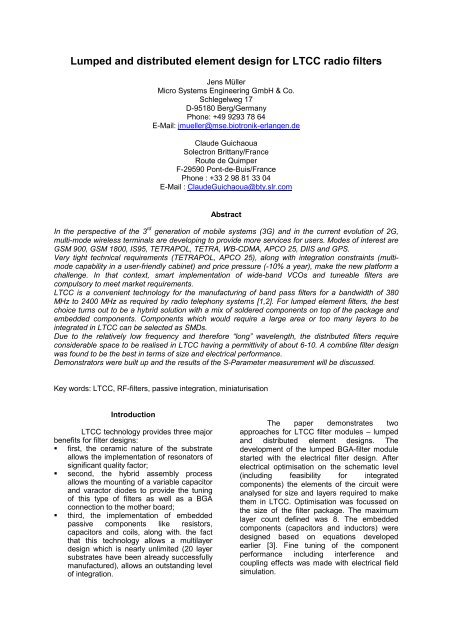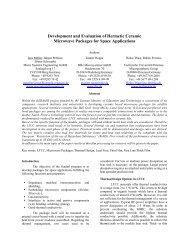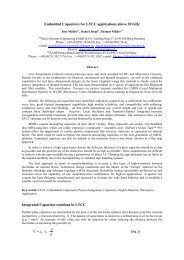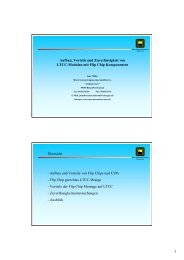Lumped and distributed element design for LTCC radio filters
Lumped and distributed element design for LTCC radio filters
Lumped and distributed element design for LTCC radio filters
Create successful ePaper yourself
Turn your PDF publications into a flip-book with our unique Google optimized e-Paper software.
<strong>Lumped</strong> <strong>and</strong> <strong>distributed</strong> <strong>element</strong> <strong>design</strong> <strong>for</strong> <strong>LTCC</strong> <strong>radio</strong> <strong>filters</strong><br />
Jens Müller<br />
Micro Systems Engineering GmbH & Co.<br />
Schlegelweg 17<br />
D-95180 Berg/Germany<br />
Phone: +49 9293 78 64<br />
E-Mail: jmueller@mse.biotronik-erlangen.de<br />
Claude Guichaoua<br />
Solectron Brittany/France<br />
Route de Quimper<br />
F-29590 Pont-de-Buis/France<br />
Phone : +33 2 98 81 33 04<br />
E-Mail : ClaudeGuichaoua@bty.slr.com<br />
Abstract<br />
In the perspective of the 3 rd generation of mobile systems (3G) <strong>and</strong> in the current evolution of 2G,<br />
multi-mode wireless terminals are developing to provide more services <strong>for</strong> users. Modes of interest are<br />
GSM 900, GSM 1800, IS95, TETRAPOL, TETRA, WB-CDMA, APCO 25, DIIS <strong>and</strong> GPS.<br />
Very tight technical requirements (TETRAPOL, APCO 25), along with integration constraints (multimode<br />
capability in a user-friendly cabinet) <strong>and</strong> price pressure (-10% a year), make the new plat<strong>for</strong>m a<br />
challenge. In that context, smart implementation of wide-b<strong>and</strong> VCOs <strong>and</strong> tuneable <strong>filters</strong> are<br />
compulsory to meet market requirements.<br />
<strong>LTCC</strong> is a convenient technology <strong>for</strong> the manufacturing of b<strong>and</strong> pass <strong>filters</strong> <strong>for</strong> a b<strong>and</strong>width of 380<br />
MHz to 2400 MHz as required by <strong>radio</strong> telephony systems [1,2]. For lumped <strong>element</strong> <strong>filters</strong>, the best<br />
choice turns out to be a hybrid solution with a mix of soldered components on top of the package <strong>and</strong><br />
embedded components. Components which would require a large area or too many layers to be<br />
integrated in <strong>LTCC</strong> can be selected as SMDs.<br />
Due to the relatively low frequency <strong>and</strong> there<strong>for</strong>e “long” wavelength, the <strong>distributed</strong> <strong>filters</strong> require<br />
considerable space to be realised in <strong>LTCC</strong> having a permittivity of about 6-10. A combline filter <strong>design</strong><br />
was found to be the best in terms of size <strong>and</strong> electrical per<strong>for</strong>mance.<br />
Demonstrators were built up <strong>and</strong> the results of the S-Parameter measurement will be discussed.<br />
Key words: <strong>LTCC</strong>, RF-<strong>filters</strong>, passive integration, miniaturisation<br />
Introduction<br />
<strong>LTCC</strong> technology provides three major<br />
benefits <strong>for</strong> filter <strong>design</strong>s:<br />
first, the ceramic nature of the substrate<br />
allows the implementation of resonators of<br />
significant quality factor;<br />
second, the hybrid assembly process<br />
allows the mounting of a variable capacitor<br />
<strong>and</strong> varactor diodes to provide the tuning<br />
of this type of <strong>filters</strong> as well as a BGA<br />
connection to the mother board;<br />
third, the implementation of embedded<br />
passive components like resistors,<br />
capacitors <strong>and</strong> coils, along with. the fact<br />
that this technology allows a multilayer<br />
<strong>design</strong> which is nearly unlimited (20 layer<br />
substrates have been already successfully<br />
manufactured), allows an outst<strong>and</strong>ing level<br />
of integration.<br />
The paper demonstrates two<br />
approaches <strong>for</strong> <strong>LTCC</strong> filter modules – lumped<br />
<strong>and</strong> <strong>distributed</strong> <strong>element</strong> <strong>design</strong>s. The<br />
development of the lumped BGA-filter module<br />
started with the electrical filter <strong>design</strong>. After<br />
electrical optimisation on the schematic level<br />
(including feasibility <strong>for</strong> integrated<br />
components) the <strong>element</strong>s of the circuit were<br />
analysed <strong>for</strong> size <strong>and</strong> layers required to make<br />
them in <strong>LTCC</strong>. Optimisation was focussed on<br />
the size of the filter package. The maximum<br />
layer count defined was 8. The embedded<br />
components (capacitors <strong>and</strong> inductors) were<br />
<strong>design</strong>ed based on equations developed<br />
earlier [3]. Fine tuning of the component<br />
per<strong>for</strong>mance including interference <strong>and</strong><br />
coupling effects was made with electrical field<br />
simulation.
Distributed <strong>filters</strong> were <strong>design</strong>ed <strong>and</strong><br />
optimised using a 3D electromagnetic field<br />
solver. These <strong>filters</strong> were not limited to 8 layers<br />
to allow a more flexible <strong>design</strong>.<br />
The demonstrators were realised with<br />
DuPont 951 material using silver pastes.<br />
Solder paste stencil printing was used <strong>for</strong><br />
bumping. After SMD mounting, the <strong>filters</strong> were<br />
singulated <strong>and</strong> assembled on a test board <strong>for</strong><br />
electrical characterization.<br />
Passive Integration<br />
Passive integration is defined as a<br />
combination of circuit carrier (substrate, board)<br />
with passive components like resistors,<br />
capacitors <strong>and</strong> inductors in one technology.<br />
Passive <strong>element</strong>s may be integrated on the<br />
surface or embedded in a multilayer structure<br />
of the substrate. The goal is to achieve:<br />
Reduced module sizes<br />
Lower costs (component reduction)<br />
Improved electrical <strong>and</strong> thermal<br />
per<strong>for</strong>mance<br />
Higher reliability (reduced number of I/O)<br />
<strong>LTCC</strong>-resistors are achieved by<br />
printing a pattern with a specific resistor paste.<br />
These pastes are available from 1 Ohm/sq. to<br />
> 10 MOhm/sq. Due to printing <strong>and</strong> other<br />
process <strong>and</strong> material tolerances, these<br />
resistors need to be trimmed. There<strong>for</strong>e,<br />
precise resistors are placed on the surface of<br />
the substrate <strong>for</strong> accessing them by laser. For<br />
lower requirements on the tolerance (e.g.<br />
> 25%) resistors can be embedded in the<br />
<strong>LTCC</strong> substrate. This can be useful <strong>for</strong> buried<br />
absorbers or internal heaters [4]. Embedded<br />
resistors may be trimmed to a desired value by<br />
high-voltage-pulse-trimming [5]. This method is<br />
very paste <strong>and</strong> <strong>design</strong> dependent.<br />
Fig. 1: Inductor <strong>design</strong>s <strong>for</strong> <strong>LTCC</strong><br />
Inductors in <strong>LTCC</strong> are made of line<br />
<strong>element</strong>s which <strong>for</strong>m a spiral or a helix. The<br />
inductance is a function of numerous<br />
parameters like number of windings, tape<br />
thickness, position to the ground plane, line<br />
width etc. Fig. 1 shows typical <strong>design</strong>s <strong>for</strong><br />
<strong>LTCC</strong> inductors. Useful inductance values <strong>for</strong><br />
printed RF-coils are in the range of 1…100nH.<br />
Capacitors can be <strong>design</strong>ed as<br />
interdigital (planar comb structure) or as plate<br />
capacitors (Fig. 2). They are simple to<br />
integrate since they are printed together with<br />
the conductor line pattern. The capacitance is<br />
a function of permittivity, plate area, distance<br />
between plates <strong>and</strong> number of plates (<strong>for</strong> a<br />
multilayer capacitor). Using the tape as<br />
dielectrics between the plates limits the useful<br />
range from 0.2 ….10pF. These capacitors are<br />
compatible with RF-requirements in terms of<br />
self resonance frequency <strong>and</strong> quality. Higher<br />
capacitance densities can only be achieved by<br />
inserting a special high-k-material between the<br />
plates [6]. Due to printing accuracy <strong>and</strong> lot to<br />
lot variation, a tolerance of about > 15% is<br />
achievable. These materials show also a poor<br />
dielectric loss behaviour which makes filter<br />
<strong>design</strong>s with high selectivity impossible. These<br />
materials were mainly developed <strong>for</strong><br />
decoupling capacitors or similar applications.<br />
Fig. 2: Multilayer plate capacitor<br />
For microwave frequencies however,<br />
passive integration is not limited to the lumped<br />
passive components mentioned above.<br />
Structures made of line <strong>element</strong>s are used to<br />
create <strong>filters</strong>, resonators, couplers etc.<br />
Depending on the line type chosen, these<br />
structures are on the surface (microstrip line)<br />
or embedded between ground planes<br />
(stripline). The latter provides reduced<br />
interactions with neighbouring components<br />
due to the complete shielding. The size of<br />
these components is related to the signal<br />
wavelength. For frequencies above 20 GHz<br />
such <strong>filters</strong> become small. In the frequency<br />
b<strong>and</strong> of interest here, they are rather large <strong>and</strong><br />
there<strong>for</strong>e not suited <strong>for</strong> high integration. The<br />
advantages of line or <strong>distributed</strong> <strong>filters</strong> are the<br />
low insertion loss <strong>and</strong> the good selectivity.<br />
General filter <strong>design</strong><br />
The <strong>LTCC</strong> <strong>filters</strong> specifications were<br />
defined from a complete <strong>radio</strong> architecture<br />
study based on a multi-mode architecture
covering both professional <strong>and</strong> public market.<br />
According to st<strong>and</strong>ard constraints (UMTS,<br />
TETRAPOL,…) the global <strong>radio</strong> architecture<br />
was defined including 1dB compression point<br />
requirements, Mixer image rejection, Mixer<br />
harmonics, Local Oscillators leakage filtering,<br />
noise dimensioning, inter-modulation requirements<br />
<strong>and</strong> filtering budget.<br />
<strong>Lumped</strong> <strong>element</strong> filter <strong>design</strong><br />
The general flow <strong>for</strong> the filter <strong>design</strong> is<br />
shown in Fig. 3. Designing a filter starts with<br />
the system requirements mentioned above. In<br />
our case the filter <strong>design</strong> <strong>and</strong> it’s optimisation<br />
was per<strong>for</strong>med by GENESYS 1 .<br />
SMD selection<br />
(RF-properties<br />
from vendor)<br />
System<br />
Specification<br />
Electrical filter<br />
synthesis, <strong>design</strong><br />
& optimisation<br />
Critical component<br />
analysis/feasibility<br />
(sensitivity)<br />
Component<br />
partitioning<br />
SMT/embedded<br />
Single component<br />
<strong>design</strong><br />
Single component<br />
verification by<br />
3D-simulation<br />
Placement in<br />
module<br />
Module verification<br />
by mixed 3D- <strong>and</strong><br />
"Black Box"<br />
simulation<br />
Finalise Layout<br />
Filter type,<br />
order<br />
estimated<br />
properties<br />
(e.g. quality)<br />
layer count,<br />
thickness,<br />
estim. area<br />
Component<br />
modification<br />
n<br />
correct<br />
behavior?<br />
y<br />
Placement<br />
modification<br />
correct<br />
behavior?<br />
Fig. 3: Design flow <strong>for</strong> filter development<br />
1 Courtesy of EAGLEWARE Inc<br />
n<br />
y<br />
Ideal components are used <strong>for</strong> the first<br />
approximation (Fig. 4). In the second step,<br />
typical <strong>element</strong> properties like losses, self<br />
resonance frequency etc. are added <strong>and</strong><br />
optimisation is repeated. Critical components<br />
can be traced by a tolerance sensitivity<br />
analysis showing the highest impact to the<br />
overall behaviour, which is also a measure <strong>for</strong><br />
manufacturability.<br />
Fig. 4: Example of filter schematic<br />
Next, the schematic is divided into<br />
integrated components <strong>and</strong> SMDs (e.g. actives<br />
<strong>for</strong> tunable <strong>filters</strong> or large capacitors). With a<br />
coarse <strong>design</strong> of the embedded components<br />
based on library <strong>element</strong>s or semi-empirical<br />
equations a first placement study <strong>and</strong> size<br />
estimation can be derived. If the area of the<br />
module is much larger than the area <strong>for</strong> the<br />
SMDs on top, some of the large integrated<br />
components should be changed to a SMD-type<br />
to get an optimum in module size (Fig. 5).<br />
Large values as SMD<br />
Fig. 5: Component partitioning<br />
After partitioning the “fine” <strong>design</strong> of<br />
embedded components is done. There are<br />
many parameters which can be adversely<br />
varied like plate area versus number of layers<br />
<strong>for</strong> a capacitor or number of turns versus coil<br />
radius <strong>for</strong> inductors. Optimisation of these<br />
<strong>design</strong>s can be either driven by size<br />
constraints or costs (e.g. number of layers).<br />
The physical dimensions of each component<br />
are obtained from semi-empirical equations or<br />
known similar <strong>element</strong>s which are already<br />
available in a data base. A library with<br />
measured or simulated electrical parameters<br />
helps to reduce the <strong>design</strong> time <strong>and</strong> increases<br />
the confidence in the <strong>design</strong>. New components<br />
should be optimised or verified by a 3dimensional<br />
electrical simulation until they<br />
show the correct behaviour (Fig. 6).
Fig. 6: Simulation structure of a 3D coil<br />
S11<br />
Fig. 7: Coil simulation results (S11, S21)<br />
up to 6 GHz<br />
The <strong>design</strong>ed <strong>LTCC</strong>-components are<br />
then arranged according to their interconnections.<br />
Symmetries in the schematic<br />
should also lead to symmetries in the placement<br />
to obtain equal conditions.<br />
Finally, a module simulation including<br />
electrical models of the SMDs, the embedded<br />
components, all connections <strong>and</strong> the module<br />
interface (e.g. solder bumps) helps to find out<br />
possible problems due to parasitic effects like<br />
cross talk or mutual inductivity. Process or<br />
material tolerances are used to assess<br />
repeatability <strong>and</strong> manufacturability. However,<br />
complex modules may be still too much <strong>for</strong><br />
simulation programs despite the increasing<br />
computing power.<br />
Fig. 8: 3D-structure of the module<br />
S21<br />
S11, S21[dB]<br />
0<br />
-20<br />
-40<br />
-60<br />
- 7µm<br />
-80<br />
0 400 800 1200 1600<br />
Frequency [Mhz]<br />
+ 7µm<br />
Fig. 9: Influence of tape thickness<br />
variation on the frequency<br />
response<br />
Distributed filter <strong>design</strong><br />
Based on the specifications from the<br />
general filter <strong>design</strong>, the synthesis of the<br />
<strong>distributed</strong> <strong>filters</strong> was per<strong>for</strong>med using<br />
GENESYS software 1 (M/FILTER module).<br />
Combline <strong>and</strong> hairpin topologies were selected<br />
due to their easy implementation <strong>and</strong><br />
integration in <strong>LTCC</strong> technology. The number of<br />
poles, the trans<strong>for</strong>mation functions (Tchebychev<br />
or Elliptic) were defined in order to meet<br />
the specifications.<br />
The initial layout was implemented in<br />
IE3D 2 software <strong>for</strong> electromagnetic simulations<br />
<strong>and</strong> optimisation in terms of space <strong>and</strong><br />
per<strong>for</strong>mance. Additionally, manufacturing<br />
constraints <strong>and</strong> tolerances as material thickness<br />
were taken into account in the <strong>design</strong><br />
optimisation, in order to improve manufacturing<br />
yield.<br />
Fig. 10: Combline filter structure (top <strong>and</strong><br />
bottom ground planes not<br />
shown)<br />
2 ZELAND Software Inc
S11, S21 [dB]<br />
0,000<br />
-10,000<br />
-20,000<br />
-30,000<br />
-40,000<br />
1,9 1,95 2 2,05 2,1 2,15 2,2 2,25 2,3<br />
frequency [GHz]<br />
Fig. 11: Simulation results <strong>for</strong> the combline<br />
filter<br />
<strong>LTCC</strong> filter realisation<br />
Both introduced <strong>filters</strong> were<br />
manufactured using DuPont Greentape 951.<br />
Though, the lumped <strong>element</strong> harmonic filter<br />
uses only 6 tape layers, it was made of 8<br />
layers to allow other filter solutions on the<br />
same test coupon. The two additional layers<br />
were provided with feed-through vias <strong>for</strong><br />
connecting the solder bumps of the BGA-type<br />
module. Due to the required thickness of the<br />
combline structure, this filter was made of 14<br />
layers. The conductor material applied was Ag<br />
to maintain very low conductive losses.<br />
After <strong>LTCC</strong>-processing, all modules<br />
were solder bumped using a stencil printing<br />
technique <strong>and</strong> reflow. The bump pitch is<br />
800 µm with a bump diameter of about<br />
300 µm. Additional 0402-SMT components<br />
were assembled on the harmonic filter<br />
modules prior to singulation from the panel.<br />
Fig. 12: Combline filter module<br />
A test PCB (Fig. 14) with 50calibration<br />
structures <strong>and</strong> SMA-connectors<br />
was used to measure the scattering<br />
parameters with a network analyzer (HP<br />
8753C).<br />
Fig. 13: Completed harmonic filter<br />
Fig. 14: RF-Test-PCB with mounted<br />
<strong>filters</strong><br />
Measurement results are shown in<br />
Figs. 15/16. The harmonic filter behaviour<br />
differs from the predicted per<strong>for</strong>mance<br />
according to the simulations. The main<br />
changes are the decreased stop frequency<br />
<strong>and</strong> the attenuation in the stop b<strong>and</strong>. The<br />
<strong>for</strong>mer leads also to a larger attenuation in the<br />
pass b<strong>and</strong>. A first analysis revealed a<br />
dominating influence of the inductors self<br />
resonance frequency <strong>and</strong> additional parasitic<br />
<strong>element</strong>s associated with the mounted SMDs.<br />
A detailed investigation is to follow.<br />
A slightly higher attenuation was<br />
obtained in the pass b<strong>and</strong> of the combline<br />
filter. This may be attributed to the AgPd-top<br />
<strong>and</strong> –bottom ground metallisation (higher Rsq.).<br />
However, the overall prediction of the filter<br />
behaviour is in good agreement with the test<br />
results (Fig. 16). For a first estimation of<br />
production tolerances, several <strong>filters</strong> have<br />
been measured <strong>and</strong> plotted in the same<br />
diagram. Fig. 17 shows data from 4 different<br />
<strong>filters</strong> from the same manufacturing lot. The<br />
filter to filter dispersion is very low, verifying<br />
the constant layer thickness (material
tolerances) <strong>and</strong> the precise stacking alignment<br />
(manufacturing tolerances).<br />
Fig. 15: Measured S-parameters of the<br />
harmonic filter<br />
dB<br />
0,000<br />
-10,000<br />
-20,000<br />
-30,000<br />
-40,000<br />
1,9 1,95 2 2,05 2,1 2,15 2,2 2,25 2,3<br />
frequency [GHz]<br />
S11[dB]<br />
S21 [dB]<br />
S11 [dB] sim<br />
S21 [dB] sim<br />
Fig. 16: Measured vs. simulated Sparameters<br />
<strong>for</strong> the combline filter<br />
Fig. 17: Measured S-Parameters of 4<br />
combline <strong>filters</strong><br />
Summary <strong>and</strong> conclusions<br />
B<strong>and</strong> pass <strong>filters</strong> <strong>for</strong> RF-applications in<br />
the frequency range from 380 MHz to 2.4 GHz<br />
have been <strong>design</strong>ed <strong>and</strong> manufactured using<br />
<strong>LTCC</strong> technology. Distributed <strong>filters</strong> (line<br />
coupled) have the disadvantage of size in the<br />
frequency range considered. The combline<br />
<strong>design</strong> offers the smallest footprint. Due to the<br />
well defined structures <strong>and</strong> boundary<br />
conditions of line <strong>filters</strong>, simulation results were<br />
in very good agreement with the measured<br />
data.<br />
<strong>Lumped</strong> <strong>element</strong> <strong>filters</strong> using<br />
embedded inductors <strong>and</strong> capacitors allow<br />
highly integrated <strong>design</strong>s. Mixing external<br />
SMDs with buried components permits very<br />
small module dimensions. However, mixed<br />
component <strong>design</strong>s are difficult to simulate<br />
accurately. Interactions between embedded<br />
<strong>element</strong>s <strong>and</strong> external components may<br />
become a dominating factor in the electrical<br />
function. The frequency behaviour of the<br />
harmonic filter realised showed large<br />
deviations from the simulated one. Reasons<br />
<strong>for</strong> this will be investigated by sub-structure<br />
measurements. Based on these data, a new,<br />
more realistic model will be established.<br />
Acknowledgements<br />
The authors would like to thank the<br />
colleagues from the Technical University of<br />
Ilmenau <strong>for</strong> the support in measuring the<br />
structures. The work carried out in the project<br />
Multi-Modules is funded by the EU within the<br />
program IST under the project number 1999-<br />
20260.<br />
References<br />
[1] N.N.: “Passive Pack in more Per<strong>for</strong>mance”,<br />
Microwave Engineering Europe, June 2002, pp. 15-<br />
18.<br />
[2] L. Devlin, G. Pearson, J. Pittcock, B. Hunt:<br />
“RF <strong>and</strong> Microwave Component Development”,<br />
Proceedings 38 th IMAPS Nordic Conference,<br />
Oslo/Norway, 2001.<br />
[3] J. Müller, H. Thust: “3D-Integration of<br />
Passive RF-Components in <strong>LTCC</strong>”, Proceedings of<br />
the Pan Pacific Conference, Maui/Hawaii, Febr.<br />
1997.<br />
[4] DuPont Thick Film News: “Highlyintegrated<br />
mm-wave modules use <strong>LTCC</strong> <strong>and</strong><br />
metallised plastic covers,” DuPont Horizons, No. 18,<br />
Dec. 2001.<br />
[5] W. Ehrhardt, H. Thust.: “Trimming of buried<br />
RuO2-based Thick Film Resistors in Multilayer<br />
Technology (<strong>LTCC</strong>) by Energy of High Voltage<br />
Pulses”, Proceedings of the 38th IMAPS Nordic<br />
Conference, Oslo, Sept. 2001.<br />
[6] J. Müller, D. Josip: “Integrated Capacitors<br />
using <strong>LTCC</strong>”, Microtech 2002, 29./30.01.2002,<br />
Manchester/UK







